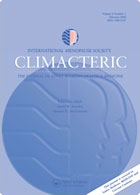SHORT REVIEW
Mammography for symptomless women - not so wise?

For Full Paper/PDF. Click Here
©Climacteric, 2013.
June 2013, Vol. 16, No. 3 , Pages 313-315 (doi:10.3109/13697137.2013.771463)
W. B. Cutler , R. E. Burki *, J. Kolter † and C. Chambliss ‡
Athena Institute for Women's Wellness, Chester Springs, PA, USA
*Salem-Hirslanden Hospital, Bern, Switzerland
†Chief of Obstetrics and Gynecology, Paoli Hospital, Paoli, PA, USA
‡Ursinus College, Collegeville, PA, USA
Correspondence: Dr W. B. Cutler, Athena Institute for Women's Wellness, 1211 Braefield Road, Chester Springs, PA 19425, USA
*Please click here for more on pheromones and books from Athena Institute
Published in the International Menopause Society's June issue of its journal Climacteric, you can on their site
Date of release: June, 2013
ABSTRACT:
For over 20 years, medical authorities have urged asymptomatic peri/postmenopausal women to undergo frequent mammography. In a recent paper (NEJM 2012;367:1998-2005), the authors tested whether early detection reduced the incidence of previously undetected late-stage cancer and saved lives. They compared data from 1976-1978 (pre-mammography) to 2006-2008 US data. Annualized age-adjusted cancer data per 100 000 women ≥ 40 years old showed that early-stage cancer detection cases increased, from 105 to 178 cases of localized disease and from seven to 56 cases of ductal carcinoma in situ; regional invasive late-stage cancer diminished slightly, from 85 to 78 cases; distant late-stage cancer showed no decline, with 17 cases in both 1976-1978 and 2006-2008; breast cancer mortality declined by 20 per 100 000 women, from 71 to 51 cases.
Since mammogram detection produced no decline in late-stage distant cancer presentations (with high mortality rates), and an extremely modest reduction in invasive regional disease (with low mortality rates), improved treatment, not early detection, is the likely engine for the lives saved.
Overdiagnosis - estimated at about 70,000 US women per year - inflicts terror, and triggers biopsies followed by unnecessary medical treatments that are painful, potentially harmful, may impair immune responsiveness and increase the risks for other cancers.
Given the availability of annual clinical exams, routine mammography screening should now be seriously questioned.
Keywords
MAMMOGRAPHY, SCREENING, BREAST CANCER, ASYMPTOMATIC PERI/POSTMENOPAUSAL WOMEN, OVERDIAGNOSIS, MORTALITY
For Full Paper/PDF. Click Here
OVERVIEW:
Overdiagnosis does medical harm to women. They suffer the terror of being told that they have breast cancer and then are subjected to biopsies and subsequent medical treatments that are painful, sometimes fraught with adverse events, detrimental to their overall well-being, inhibit their sexual relationship, and impair their immune system. Recent work has demonstrated that routine cancer treatments elevate the risk for future cancers in other organs, most likely because they inhibit the immune function designed to combat the ever-increasing, age-related mutations that lead to cancer 2 – 4 . And perhaps worse, women thus treated may erroneously believe they have been ‘ saved ’ when actually they have been harmed.
In 2009, a comprehensive analysis from the Cancer Control Division of the US CDC, presented data including all cases of breast cancer in women in 92.1% of the US population for 6 consecutive years. Dr Eheman and colleagues cited methodology stating that, in these data, one woman could be counted more than once, i.e. if she presented with more than one primary tumor 5 . Interestingly, the average age- adjusted annualized DCIS rates in the parallel age groups of the Eheman data (1999–2004) and for the 2006–2008 time period in the Bleyer and Welch article are identical (56 per 100,000 women). This is noteworthy given the fact that postmenopausal hormone use had decreased precipitously by 2006–2008, a fact that has been held responsible for a perceived decrease in early-stage breast cancer rates post- WHI in other publications using SEER data 6.
Interest groups, like the Susan Komen Race for the Cure, have encouraged public perception influencing the current routine reimbursement of the screenings and the medical treatment that follows. As a consequence, huge financial resources have gone to the construction and staffing of mammography centers, leading to both widespread marketing and media advertising to get women to use them. This investment in staff, equipment, research centers and advertising has created a huge and powerful group of financial stakeholders in maintaining this status quo. It has also supplied an enormous pool of data suggesting that over 1 million women in the US have undergone invasive and toxic treatments that likely diminished the quality of their health rather than enhanced it.
We agree with Drs Bleyer and Welch: women and their health advisers can now be clear that routine mammography is not necessarily in women’s best interest.
TAKE HOME MESSAGES:
- Credible data showing most mortality reduction in breast cancer results from improved medical treatment rather than from early mammographic detection.
- Routine mammography screening produces substantial overdiagnosis that inflicts arguably more harm than good.
- Routine mammography screening should be seriously questioned, since annual clinical examinations (without mammograms) can find disease before the development of distant disease and result in less overdiagnosis that triggers unnecessary and potentially harmful treatment.
*Related book by Dr. Cutler: Hormones and Your Health